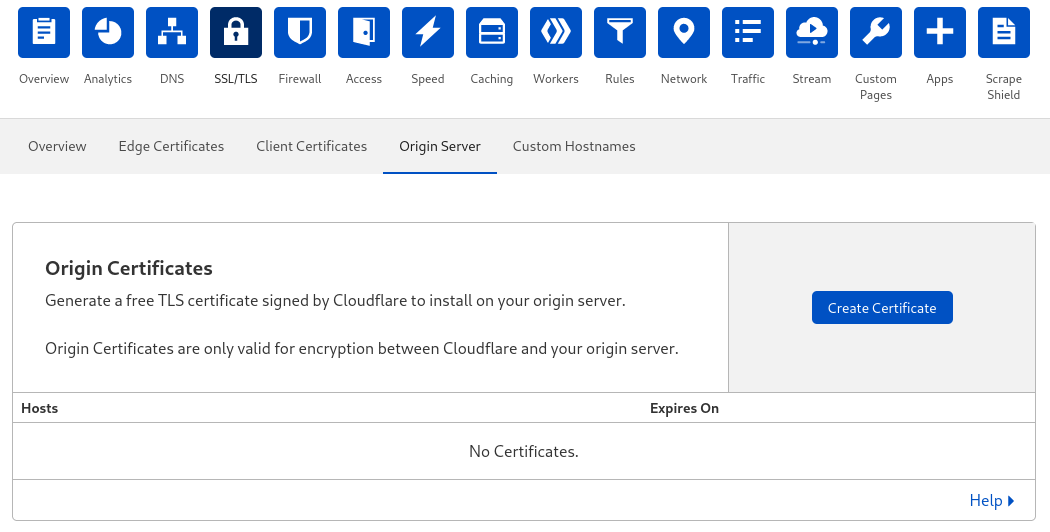Caddy setup with Cloudflare
What we want to achieve
In this post, we'll setup a Caddy reverse proxy situated behind the protections of Cloudflare. We'll setup authenticated TLS pulls, so only connections from Cloudflare servers are allowed and use a Cloudflare certificate to encrypt the data from Caddy to Cloudflare.

- Head to SSL/TLS > Origin Server

- Click
Create Certificate - Select
RSA (2048)and you'll probably want a period of over 3 years for convenience.

- Create a
certfolder.
cd
mkdir cert
cd cert
- Using the
PEMkey format copy and paste the Origin Certificate toexample.com.pemand the Private Key intoexample.com.key.
- Add the following line to your Caddyfile
tls <Path to PEM> <Path to KEY>
Example:
cyberhost.uk {
tls /file_path/cyberhost.uk.pem /file_path/cyberhost.uk.key
reverse_proxy 127.0.0.1
}
Reload config: caddy reload
Setup Cloudflare TLS Authenticated Pull
The issue
Cloudflare is used for their industry-leading DDoS and security benefits, so we don't want anyone being able to bypass this protection!
Cloudflare can be bypassed by sending a host header to the origin IP.
Example:
curl --resolve '<DOMAIN>:<PORT>:<Origin-IP>' https://<DOMAIN> -k
curl --resolve 'example.com:443:93.184.216.34' https://example.com -k
The fix
One solution is to use an allowlist/whitelist with Cloudflare's IP Ranges however these can change over time. The best solution is to cryptographically authenticate all clients trying to load your website.
- Enable 'Authenticated Origin Pulls' in Cloudflare.
SSL/TLS -> Origin Server

- Get a copy of the Cloudflare Certificate here.
Also available here:
-----BEGIN CERTIFICATE-----
MIIGCjCCA/KgAwIBAgIIV5G6lVbCLmEwDQYJKoZIhvcNAQENBQAwgZAxCzAJBgNV
BAYTAlVTMRkwFwYDVQQKExBDbG91ZEZsYXJlLCBJbmMuMRQwEgYDVQQLEwtPcmln
aW4gUHVsbDEWMBQGA1UEBxMNU2FuIEZyYW5jaXNjbzETMBEGA1UECBMKQ2FsaWZv
cm5pYTEjMCEGA1UEAxMab3JpZ2luLXB1bGwuY2xvdWRmbGFyZS5uZXQwHhcNMTkx
MDEwMTg0NTAwWhcNMjkxMTAxMTcwMDAwWjCBkDELMAkGA1UEBhMCVVMxGTAXBgNV
BAoTEENsb3VkRmxhcmUsIEluYy4xFDASBgNVBAsTC09yaWdpbiBQdWxsMRYwFAYD
VQQHEw1TYW4gRnJhbmNpc2NvMRMwEQYDVQQIEwpDYWxpZm9ybmlhMSMwIQYDVQQD
ExpvcmlnaW4tcHVsbC5jbG91ZGZsYXJlLm5ldDCCAiIwDQYJKoZIhvcNAQEBBQAD
ggIPADCCAgoCggIBAN2y2zojYfl0bKfhp0AJBFeV+jQqbCw3sHmvEPwLmqDLqynI
42tZXR5y914ZB9ZrwbL/K5O46exd/LujJnV2b3dzcx5rtiQzso0xzljqbnbQT20e
ihx/WrF4OkZKydZzsdaJsWAPuplDH5P7J82q3re88jQdgE5hqjqFZ3clCG7lxoBw
hLaazm3NJJlUfzdk97ouRvnFGAuXd5cQVx8jYOOeU60sWqmMe4QHdOvpqB91bJoY
QSKVFjUgHeTpN8tNpKJfb9LIn3pun3bC9NKNHtRKMNX3Kl/sAPq7q/AlndvA2Kw3
Dkum2mHQUGdzVHqcOgea9BGjLK2h7SuX93zTWL02u799dr6Xkrad/WShHchfjjRn
aL35niJUDr02YJtPgxWObsrfOU63B8juLUphW/4BOjjJyAG5l9j1//aUGEi/sEe5
lqVv0P78QrxoxR+MMXiJwQab5FB8TG/ac6mRHgF9CmkX90uaRh+OC07XjTdfSKGR
PpM9hB2ZhLol/nf8qmoLdoD5HvODZuKu2+muKeVHXgw2/A6wM7OwrinxZiyBk5Hh
CvaADH7PZpU6z/zv5NU5HSvXiKtCzFuDu4/Zfi34RfHXeCUfHAb4KfNRXJwMsxUa
+4ZpSAX2G6RnGU5meuXpU5/V+DQJp/e69XyyY6RXDoMywaEFlIlXBqjRRA2pAgMB
AAGjZjBkMA4GA1UdDwEB/wQEAwIBBjASBgNVHRMBAf8ECDAGAQH/AgECMB0GA1Ud
DgQWBBRDWUsraYuA4REzalfNVzjann3F6zAfBgNVHSMEGDAWgBRDWUsraYuA4REz
alfNVzjann3F6zANBgkqhkiG9w0BAQ0FAAOCAgEAkQ+T9nqcSlAuW/90DeYmQOW1
QhqOor5psBEGvxbNGV2hdLJY8h6QUq48BCevcMChg/L1CkznBNI40i3/6heDn3IS
zVEwXKf34pPFCACWVMZxbQjkNRTiH8iRur9EsaNQ5oXCPJkhwg2+IFyoPAAYURoX
VcI9SCDUa45clmYHJ/XYwV1icGVI8/9b2JUqklnOTa5tugwIUi5sTfipNcJXHhgz
6BKYDl0/UP0lLKbsUETXeTGDiDpxZYIgbcFrRDDkHC6BSvdWVEiH5b9mH2BON60z
0O0j8EEKTwi9jnafVtZQXP/D8yoVowdFDjXcKkOPF/1gIh9qrFR6GdoPVgB3SkLc
5ulBqZaCHm563jsvWb/kXJnlFxW+1bsO9BDD6DweBcGdNurgmH625wBXksSdD7y/
fakk8DagjbjKShYlPEFOAqEcliwjF45eabL0t27MJV61O/jHzHL3dknXeE4BDa2j
bA+JbyJeUMtU7KMsxvx82RmhqBEJJDBCJ3scVptvhDMRrtqDBW5JShxoAOcpFQGm
iYWicn46nPDjgTU0bX1ZPpTpryXbvciVL5RkVBuyX2ntcOLDPlZWgxZCBp96x07F
AnOzKgZk4RzZPNAxCXERVxajn/FLcOhglVAKo5H0ac+AitlQ0ip55D2/mf8o72tM
fVQ6VpyjEXdiIXWUq/o=
-----END CERTIFICATE-----
Paste the certificate into a file e.g /file_path/origin-pull-ca.pem
- Now extend the tls directive in your Caddyfile to add client auth
cyberhost.uk {
tls /file_path/cyberhost.uk.pem /file_path/cyberhost.uk.key {
client_auth {
mode require_and_verify
trusted_ca_cert_file /file_path/origin-pull-ca.pem
}
}
reverse_proxy 127.0.0.1
}
- Now when we try to bypass Cloudflare we are denied access!
curl --resolve 'example.com:443:93.184.216.34' https://example.com -k
Error:
curl: (56) OpenSSL SSL_read: error:14094412:SSL routines:ssl3_read_bytes:sslv3 alert bad certificate, errno 0




